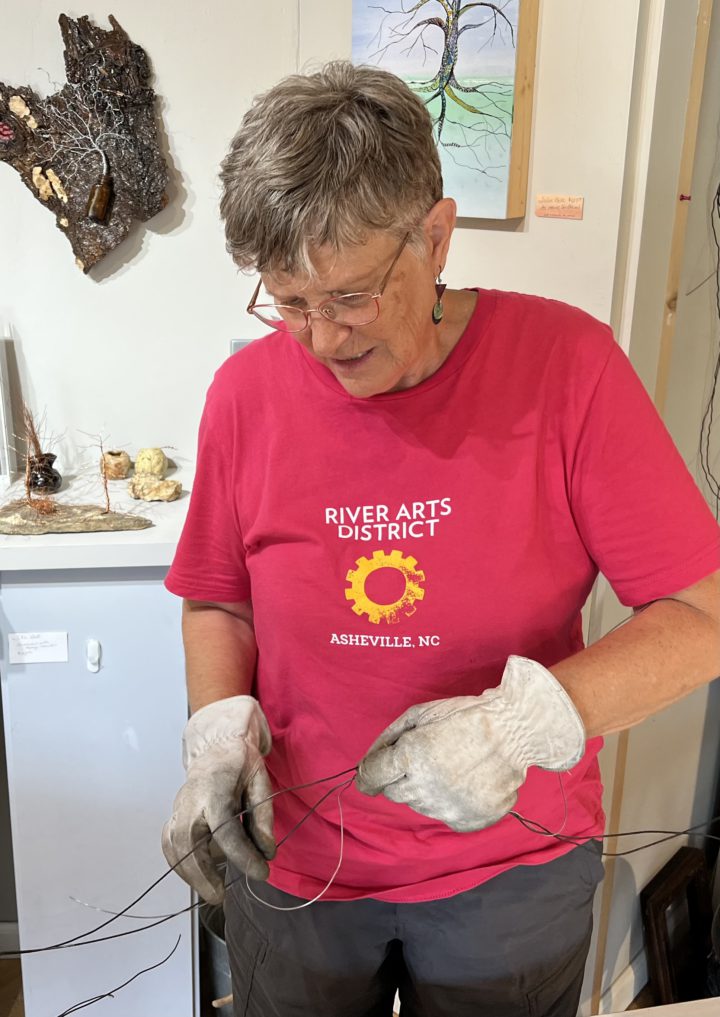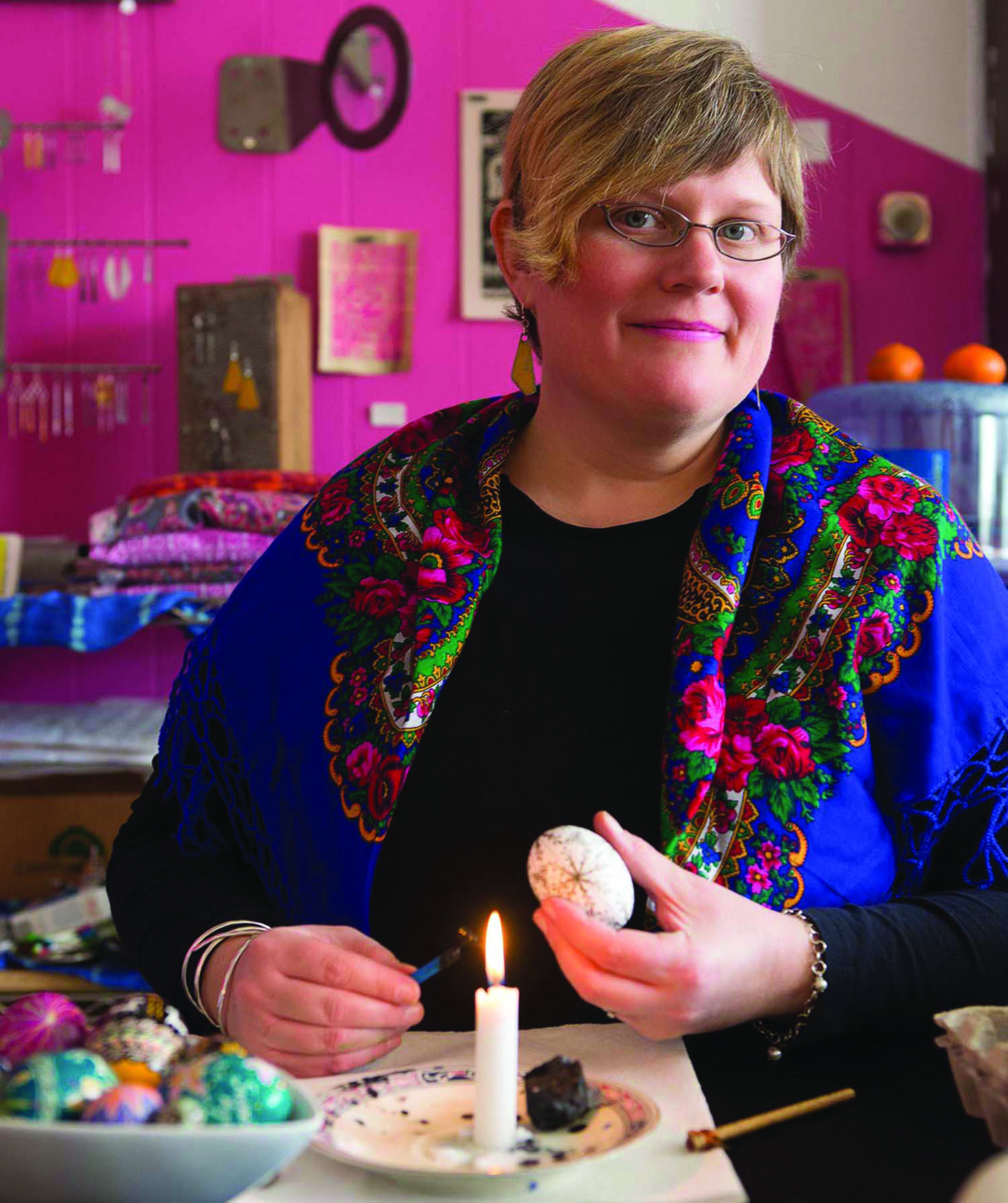When Andrea Kulish and her husband, musician Chris Wilhelm, first came to the River Arts District in 2013 from Boston, they felt right at home among fellow artists and musicians residing in the gritty and creative hub nestled along the French Broad River.
“We were both drawn by the arts and music. And at the time, Asheville was more affordable for us,” says Kulish, a graphic designer who specializes in Ukrainian pysanky eggs and other mixed media. “I always wanted to have my own studio and gallery, and that seemed possible here.”
That dream became a reality nearly a decade ago when Kulish decided to rent a space — a 650-square-foot studio and gallery shared with another artist — at the Pink Dog Collective, one of several warehouse-turned-artist-studios in the RAD.
But a lot has changed in the nearly 10 years since Kulish moved to Asheville. And as residents flock to Asheville, investors follow, snapping up buildings despite rising prices, which in turn elevates the value of nearby buildings. As the 2022 property tax assessment shows, taxes will rise too. Artists in the River Arts District thereby contend with the rising cost of studio space caused by inflation, property tax increases and maintenance costs associated with older buildings.
“Artists [in the RAD] are very concerned. We don’t know how long we might be here,” Kulish remarks. “At the same time, we are hoping to work with the city and the community to try to keep the art in the Arts District.”
Moving in
The RAD, which was once home to about two dozen factories that produced textiles, grain and other goods, began experiencing a renaissance in the 1970s, as artists and investors began to acquire a number of properties and transform the buildings into studios and galleries and rent them at very affordable rates to area artists.
Among those early investors was Hedy Fischer, who co-owns a building at 342-348 Depot St. in the RAD with her business partner Randy Shull. The duo bought the 1920s-era building, which once served as a textile warehouse, and converted it into artist studios in 2010.
“When we purchased it, it was filled from floor to ceiling with boxes of cheap Chinese textiles being sold on Overstock.com,” Fischer recalls. “The building needed a lot of work, and we did most of it ourselves. We envisioned other artists having studios there and we envisioned a restaurant.” The building now houses the Pink Dog Collective, which supports 34 artists, as well as two restaurants and Asheville’s first and only Black-owned coffee shop, Grind AVL.
From 2010-20 alone, the number of restaurants in the area grew from three to 15, recreation businesses increased from two to five, and the number of artists grew from about 140 across 16 buildings to more than 250 in 19 buildings, according to previous reporting from Xpress.
Construction of RADTIP — the River Arts District Transportation Improvement Project — which began in 2018, brought greenway paths, improved streets, additional park space, more parking, landscaping, sidewalks, public art, seating, measures to handle stormwater, swings and much improved facilities for bicycles to the 2-mile stretch of riverfront between the Amboy Road/Lyman Street/Meadow Road intersection to the south to a point just north of the railroad bridge over Riverside Drive.
And at least five housing new housing projects in the RAD are under construction, in development or coming online this year alone, including 665 new apartments, thousands of square feet of commercial space, two hotels and an 16-unit camping center.
The growth has been great for artists in the RAD in a lot of ways, says Julie Ann Bell, a local wire artist and co-owner of Trackside Studios on Depot Street. Bell has rented space in the building since 2009.

“We’re thrilled that there are restaurants and breweries and things like that because we want them to stay in the district for a few hours when people come down to look at art,” says Bell, who also serves as president of the River Arts District Artists, a coalition of roughly 300 RAD artists.
Going up
But as investments in the RAD continue to stack up, fears regarding gentrification and increased cost of living begin to take hold among both artists and building owners. Fischer notes that one of the biggest factors in determining studio rental rates are property taxes, which saw a large jump after the 2017 reassessment.
“In the almost 13 years we have owned Pink Dog, all expenses have increased, but perhaps most dramatically has been the property taxes, which have increased over 160% since we purchased the building,” Fischer explains.
Those increases trickle down to artists who rent studio space, says Bell. As property taxes put pressure on building owners and thereby rent, some artists are pushed out of the area. “Our rent went up 30%,” Bell notes, recalling the rate hike in 2017.
And more tax increases are coming. Buncombe County’s latest property tax revaluation, released in February of last year, shows double-digit percentage increases in nearly all areas of the county since the last assessment in 2017.
Outside of property taxes, Fischer says that costs of maintenance, parking, insurance and other factors all contribute to higher studio rates as building owners attempt to keep up.
“Everything has gone up,” she explains “I don’t know if gentrification is the term I would use just yet, but many of the other buildings around us have been bought and renovated since we bought Pink Dog. It still feels a little funky on Depot Street, but the fact that many buildings have been renovated likely plays into the city and county’s property assessments.”
Despite the challenges, Fischer says that she and Hull have worked to keep rent reasonable for the Pink Dog’s artists, noting that rents typically only rise between 2%-4% per year outside of property tax increases. That effort doesn’t go unnoticed by the building’s occupants, many of whom have been tenants for 10 or more years. Both Bell and Kulish express gratitude to their respective landlords who have been supportive of artists in the area.
“I feel I am very lucky to be in a building where the owners (Fischer and Shull) care about the artists and do what they can to keep our rents affordable,” Kulish maintains.
Holding the line
While the future of the RAD is uncertain, Fischer says that she predicts that the influx of new residents will increase the need for practical businesses, such as grocery stores and retail shops. But she doesn’t see that as a force that will push all artists out of the area.
“I don’t have a crystal ball, but I think there will be artists in the RAD for many more years. As rents rise, so does the price of art that is sold, so hopefully, artists will be able to continue to afford a place to work in the RAD,” she explains.
“You see these numbers about how the arts have brought billions of dollars in revenue to Asheville, and that means something,” Kulish adds. “If we’re not here and if this goes away, that’s going to change what it is people love about Asheville.”
Bell agrees and adds that it will take a community effort to keep art in the area.
“I believe there will always be arts in the Arts District, because I believe that there are people and building owners who believe in the arts. I am so grateful to those building owners,” Bell says. “I am, by nature, an optimist. And I truly believe that there will be arts in the Arts District.”






Before you comment
The comments section is here to provide a platform for civil dialogue on the issues we face together as a local community. Xpress is committed to offering this platform for all voices, but when the tone of the discussion gets nasty or strays off topic, we believe many people choose not to participate. Xpress editors are determined to moderate comments to ensure a constructive interchange is maintained. All comments judged not to be in keeping with the spirit of civil discourse will be removed and repeat violators will be banned. See here for our terms of service. Thank you for being part of this effort to promote respectful discussion.